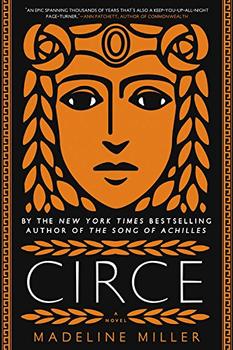Summary | Excerpt | Reading Guide | Reviews | Beyond the Book | Read-Alikes | Genres & Themes | Author Bio

This article relates to Circe
 The nature of nymphs, the "least of the lesser goddesses," as they are referred to in Circe, is central to the novel. Circe, herself a sorceress or witch nymph, is most famous for turning Odysseus' crew into wild pigs and later becoming the hero's lover and adviser. In Greek mythology, nymphs are female spirits associated with the natural world. There are various kinds of nymphs presiding over all aspects of nature such as the Naiads and Oceanids of the waters and the Dryads of the forests. There are even breeze and star nymphs such as the Aurae and Asteriae.
The nature of nymphs, the "least of the lesser goddesses," as they are referred to in Circe, is central to the novel. Circe, herself a sorceress or witch nymph, is most famous for turning Odysseus' crew into wild pigs and later becoming the hero's lover and adviser. In Greek mythology, nymphs are female spirits associated with the natural world. There are various kinds of nymphs presiding over all aspects of nature such as the Naiads and Oceanids of the waters and the Dryads of the forests. There are even breeze and star nymphs such as the Aurae and Asteriae.
The nymphs are rarely central protagonists of myths and are more generally seen to be companions to the Olympians. As an infant, Zeus himself was protected and nursed by the nymphs of Mount Ida, Adrasteia and Ida. The head Olympian later rewarded his childhood minders by turning them into the constellations Ursa Major and Minor. The goddess of hunting, Artemis, was accompanied by faithful huntress nymphs. Similarly, the Lampads were the torch-bearing nymph companions of the Underworld goddess Hecate, given to her as a gift from Zeus for her loyalty to him in the Titanomachy, the epic battle between the Titans and Olympians for control of the cosmos. However, there are a few legends where nymphs feature more prominently.
As mother to Achilles, regarded as the greatest of warriors in the Trojan War, the goddess of water Thetis is one of the most popular nymphs in the Greek mythos. This sea nymph's story is particularly noteworthy for how she was forced into marriage by the mortal Peleus. After the death of his wife Antigone, the sea-god Proteus advised Peleus to take Thetis as his new bride. Knowing she wouldn't accept, Proteus told Peleus to bind Thetis while she was asleep in order to stop her from changing form and thereby escaping. Realizing she was trapped, Thetis violently shape-shifted into flame, water, a lioness and serpent, but Peleus held tight and managed to overpower her. Once calm, Thetis agreed to marry Peleus. Their marriage produced seven sons in total, six of whom died in infancy. Achilles was the only one to survive and, in an attempt to make her beloved son invincible, Thetis is said to have dipped him into the River Styx by holding him by the heel, the sole part of his body that remained vulnerable and would ultimately lead to his downfall. It's what gives us the expression, "Achilles heel."
While Scylla is more commonly known as the terrifying multi-headed sea monster from Homer's Odyssey, later interpretations of her origin story revealed that this ugly abomination was initially a beautiful nymph. As told in Ovid's Metamorphosis — the tale which is adapted by Miller in Circe with slight variations — Scylla's story is a love triangle with Glaucus and Circe. While the fisherman-turned-god Glaucus was enamored with Scylla, the nymph felt repulsed by him and fled from his sight. In an attempt to win her affections, Glaucus sought help from the witch Circe, asking her to produce a love potion for him to win Scylla's heart. In a twist of fate, Circe herself became infatuated with Glaucus. But upon realizing she held no sway over him, Circe became bitterly jealous. She concocted a poison which she poured into Scylla's pool of water, transforming the maiden into the legendary monstrosity who attacked ships and sailors passing through her channel of water.
Picture of statue of Circe at Versaiiles by Laurent Magnier and Vincent Torri
Filed under Places, Cultures & Identities
![]() This "beyond the book article" relates to Circe. It originally ran in April 2018 and has been updated for the
April 2020 paperback edition.
Go to magazine.
This "beyond the book article" relates to Circe. It originally ran in April 2018 and has been updated for the
April 2020 paperback edition.
Go to magazine.
Your guide toexceptional books
BookBrowse seeks out and recommends the best in contemporary fiction and nonfiction—books that not only engage and entertain but also deepen our understanding of ourselves and the world around us.